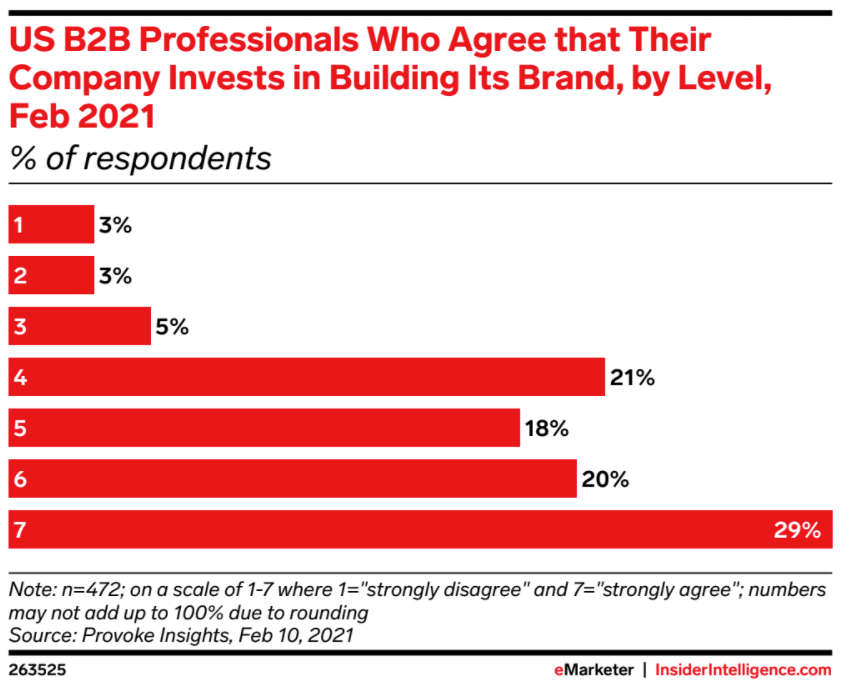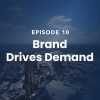Account-based marketing presupposes that leads are not the goal of the program. After all, it’s not called lead-based marketing. Rather than hoping someone fills out a form, modern go-to-market teams today focus on creating awareness and traffic. This translates into signals (engagement data, intent data, etc.) that outbound and sales teams can then use to understand and prioritize their accounts as they progress to revenue opportunities. So if awareness and traffic is the goal, what’s the strategy? Brand.
As a reformed B2B demand gen marketer myself, I know how that might sound questionable. You need to be measured on numbers, and brand is notoriously unquantifiable. Our CEO (and a former badass CMO), Tim Kopp, explained how brand drives demand on an episode of The Roof.
The Power of Brand
If you didn’t watch the video, here’s the key sentence: “Think about the biggest traffic days on your website. It wasn’t advertising, it was a big announcement, product enhancement, etc.” Creating a magnetic brand is so much more important than just raw lead generation.
Are you supposed to give up leads? If we’re talking about leads as raw marketing performance, then yes, absolutely, get rid of ‘em. If we’re talking about leads as qualified inbound requests who know what you’re about and need help making a buying decision, then no. Here’s the thing though: If you’re reading this blog post, you’re probably not a highly transactional, product-led solution that would benefit from a coordinated go-to-market strategy. You should keep running those performance-marketing campaigns. However, if you’re serving buyers who are solving complicated problems and, according to Demand Gen Report, have buying cycles approaching 18 months then you need to be playing the long game. How do you get those people to fill out a form or agree to a meeting request sent by your sales team? Saying it again, louder this time, brand.
Jillian Ryan of Insider Intelligence recently released a fantastic report on B2B Brand Strategy that you should check out. In it, Jon Lombardo, global lead at LinkedIn’s The B2B institute said, “Marketers are ignoring a large portion of potential buyers that aren’t in market now, but might be in the future. Brand marketing ensures that in two years, when those buyers are in market, you are top of mind over your competitors that don’t invest as heavily in branding.” That’s a statement that’s easy to agree with but here’s the rub: In that same report, Provoke Insights found that already 67% of US B2B professionals agreed that their company already invests in building their brand.

If you agree that investing in your brand is important but over 67% of your competitors also agree, what do you do to really stand out?
Be Bold
Creating a magnificent brand that’s the darling of your addressable market is a rare feat that few of us will ever achieve. That doesn’t mean you should be timid about it though. As brand genius, Martin Wigel, said: “You can be relevant as hell, but boring as f***.” It’s a noisy marketplace and it takes a lot to stand out in it.
Get Personal
It’s hard to get the entire world to fall in love with your brand. Your total addressable market, and even more granularly, your total relevant market though? Less difficult if you care and take the time to create tailored brand messages. Creating very specific segments out of your total relevant market and targeting them with specific messaging will turn strangers into huge fans of your brand. (Hey wait a minute, that sounds like ABM!).
Focus On What’s Most Important
Ask your CMO if she or he would rather you focus on a lead gen number or get your most important audiences to spend more meaningful time with your brand. You can’t just trick more leads into buying more. You certainly can, however, get your most likely buyers to volunteer to spend some time with your brand, get to know your product or service, and understand how it can help them reach their goals.
I’m going to say this one last time as someone with firsthand experience: It is entirely possible to build a revenue engine that benefits from, but does not rely on leads. According to our 2020 State of ABM Report, mature account-based companies don’t count leads in their Top 3 KPIs for their ABM program. The most important thing was new business generation, which comes from creating an authentic, relevant, and bold brand that people want to spend more time with.


It is possible to hit your revenue goals without generating leads. When less than 1% of leads become customers, it becomes an unreliable indicator of revenue performance. That’s why modern go-to-market teams today focus on likely future customers. Then they generate awareness, interest, and revenue opportunities without waiting on these accounts to fill out a form. An account-based approach (or non-leads approach) is a much more efficient acquisition engine, and it leads to a superior end-to-end customer experience.
History says now is the time to invest in brand (I explain more in this blog post for those interested). So, what are you waiting for?
